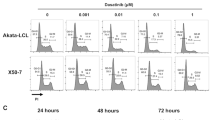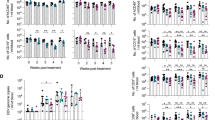Abstract
Epstein–Barr virus (EBV)-positive B-cell lymphoproliferative disease develops in severe combined immunodeficient (SCID) mice inoculated with peripheral blood mononuclear cells (PBMC) from EBV+ individuals (SCID/hu mice). In this study, we investigated the contribution of EBV reactivation and de novo infection of B lymphocytes to tumor outgrowth in SCID/hu mice. Evaluation of BZLF-1, an early EBV activation transcript, in cells recovered from the mouse peritoneal cavity within 16 days following PBMC transfer did not reveal EBV reactivation, while BZLF-1 expression was only detected in tumor masses or in vitro established lymphoblastoid cell lines. To confirm these data by a different strategy, we coinjected PBMC from seropositive donors with purified B cells from seronegative donors of different sex. Fluorescence in situ hydridization analysis of the resulting tumor masses disclosed that the overwhelming majority of lymphoma cells originated from the seropositive donor, implying that no substantial in vivo production and transmission of virus had occurred. Further, treatment of SCID/hu mice with ganciclovir did not prevent lymphoma development. Our results suggest that in the SCID/hu mouse, early EBV replication and secondary infection of bystander B cells does not occur, and that the direct outgrowth of the transformed B lymphocytes present within the PBMC inoculum is the predominant mechanism, which leads to lymphoma generation in this experimental model.
This is a preview of subscription content, access via your institution
Access options
Subscribe to this journal
Receive 12 print issues and online access
$259.00 per year
only $21.58 per issue
Buy this article
- Purchase on Springer Link
- Instant access to full article PDF
Prices may be subject to local taxes which are calculated during checkout





Similar content being viewed by others
References
Rickinson AB, Kieff E . Epstein–Barr virus. In: Fields BN, Knipe DM, Howley PM (eds). Fields Virology, 4th edn, Vol. 2. Philadelphia: Lippincott-Raven Publishers, 2001, pp 2511–2627.
Tierney RJ, Steven N, Young LS, Rickinson AB . Epstein–Barr virus latency in blood mononuclear cells: analysis of viral gene transcription during primary infection and in the carrier state. J Virol 1994; 68: 7374–7385.
Rickinson AB, Moss DJ . Human cytotoxic T lymphocyte responses to Epstein–Barr virus infection. Annu Rev Immunol 1997; 15: 405–431.
Khanna R, Burrows SR, Moss DJ . Immune regulation in Epstein–Barr virus-associated diseases. Microbiol Rev 1995; 59: 387–405.
Rickinson AB, Lee SP, Steven NM . Cytotoxic T lymphocyte responses to Epstein–Barr virus. Curr Opin Immunol 1996; 8: 492–497.
Fu Z, Cannon MJ . Functional analysis of the CD4+ T-cell response to Epstein–Barr virus: T-cell-mediated activation of resting B cells and induction of viral BZLF1 expression. J Virol 2000; 74: 6675–6679.
Bosma GC, Custer RP, Bosma MJ . A severe combined immunodeficiency mutation in the mouse. Nature (London) 1983; 301: 527–530.
Custer RP, Bosma GC, Bosma MJ . Severe combined immunodeficiency (SCID) in the mouse. Pathology, reconstitution and neoplasms. Am J Pathol 1985; 120: 464–477.
Mosier DE, Gulizia RJ, Baird SM, Wilson DB . Transfer of a functional human immune system to mice with severe combined immunodeficiency. Nature (London) 1988; 335: 256–259.
Veronese ML, Veronesi A, D'Andrea E, Del Mistro A, Indraccolo S, Mazza MR et al. Lymphoproliferative disease in Human peripheral blood mononunclear cell-injected SCID mice. T lymphocyte requirement for B cell tumor generation. J Exp Med 1992; 176: 1763–1767.
Johannesen M, Asghar M, Crawford DH . Essential role for T cells in human B-cell lymphoproliferative disease development in severe combined immunodeficient mice. Br J Haematol 2000; 109: 600–610.
Hussel T, Isaacson PG, Crabtree JE, Spencer J . The response of cells from low-grade B-cell gastric lymphomas of mucosa-associated lymphoid tissue to Helicobacter pylori. Lancet 1993; 342: 571–574.
Miyashita EM, Yang B, Lam KMC, Crawford DH, Thorley-Lawson DA . A novel form of Epstein–Barr virus latency in normal B cells in vivo. Cell 1995; 80: 593–601.
Thiele DL, Kurosaka M, Lipsk PE . Phenotype of the accessory cell necessary for mitogen-stimulated T and B cell responses in human peripheral blood: delineation by its sensitivity to the lysosomotropic agent, L-leucine methyl ester. J Immunol 1983; 131: 2282–2290.
Coppola V, Veronesi A, Indraccolo S, Calderazzo F, Mion M, Minuzzo S et al. Lymphoproliferative disease in human peripheral blood mononuclear cell-injected SCID mice. IV. Differential activation of human Th-1 and Th-2 lymphocytes and influence of the atopic status on lymphoma development. J Immunol 1998; 160: 2514–2522.
Amadori A, Zamarchi R, De Silvestro G, Forza G, Cavatton G, Danieli GA et al. Genetic control of the CD4/CD8 T cell ratio in humans. Nat Med 1995; 1: 1279–1283.
Tosato G, Pike SE, Koski IR, Blaese RM . Selective inhibition of immunoregulatory cell functions by cyclosporin A. J Immunol 1982; 128: 1986–1991.
Pinkel D, Straume T, Gray JW . Cytogenetic analysis using quantitative, high sensitivity, fluorescence hybridization. Proc Natl Acad Sci USA 1986; 83: 2934–2938.
Polack A, Hartl G, Zimber U, Freese UK, Laux G, Takaki K et al. A complete set of overlapping cosmid clones of M-ABA virus derived from nasopharyngeal carcinoma and its similarity to other Epstein–Barr virus isolates. Gene 1984; 27: 279–288.
Alfarano A, Indraccolo S, Circosta P, Minuzzo S, Vallario A, Zamarchi R et al. An alternatively spliced form of CD79b gene may acount for altered B-cell receptor expression in B-chronic lymphocytic leukemia. Blood 1999; 93: 2327–2335.
Indraccolo S, Gola E, Rosato A, Minuzzo S, Habeler W, Tisato V et al. Differential effects of angiostatin, endostatin and interferon-α1 gene transfer on in vivo growth of human breast cancer cells. Gene Therapy 2002; 9: 867–878.
Santini SM, Rizza P, Logozzi MA, Sestili P, Gherardi G, Lande R et al. The SCID mouse reaction to human peripheral blood mononuclear leukocyte engraftment. Transplantation 1995; 60: 1306–1314.
Fukuda M, Satoh TA, Takanashi M, Hirai K, Ohnishi E, Sairenji T . Inhibition of cell growth and Epstein–Barr virus reactivation by CD40 stimulation in Epstein–Barr virus-transformed B cells. Viral Immunol 2000; 13: 215–229.
Rowe M, Young LS, Crocker J, Stokes S, Henderson S, Rickinson AB . Epstein–Barr virus (EBV)-associated lymphoproliferative disease in the SCID mouse model: implications for the pathogenesis of EBV-positive lymphomas in man. J Exp Med 1991; 173: 147–158.
Schimke RT, Hill A, Johnston RN . Fifth Gordon Hamilton–Farley memorial lecture. Methotrexate resistance and gene amplification: an experimental model for the generation of cellular heterogeneity. Br J Cancer 1985; 51: 459–465.
Larkins BA, Dilkes BP, Dante RA, Coelho CM, Woo YM, Liu Y . Investigating the hows and whys of DNA endoreduplication. J Exp Bot 2001; 52: 183–192.
Armitage JM, Kormos RL, Stuart RS, Fricker FJ, Griffith BP, Nalesnik M et al. Post transplant lymphoproliferative disease in thoracic organ transplant patients: Ten years of cyclosporine-based immunosuppression. J Heart Lung Transplant 1991; 10: 877–887.
Knowles DM, Cesarmen E, Chadburn A, Frizzera G, Chen J, Rose EA et al. Correlative morphologic and genetic analysis demonstrates three distinct categories of post-transplantation lymphoproliferative disorders. Blood 1995; 85: 552–565.
Barrett JC . Posttransplantation lymphoproliferative disease. HERPES 2000; 7: 4–8.
Amadori A, Veronesi A, Coppola V, Indraccolo S, Mion M, Chieco-Bianchi L . The hu-PBL-SCID mouse in human lymphocyte function and lymphomagenesis studies: achievements and caveats. Semin Immunol 1996; 8: 249–254.
Srivastava T, Zwick DL, Rothberg PG, Warady BA . Posttransplant lymphoproliferative disorder in pediatric renal transplantation. Pediatr Nephrol 1999; 13: 748–754.
Birkeland SA, Andersen HK, Hamilton-Dutoit SJ . Preventing acute rejection, Epstein–Barr virus infection, and posttransplant lymphoproliferative disorders after kidney transplantation: use of acyclovir and mycophenolate mofetil in a steroid-free immunosuppressive protocol. Transplantation 1999; 67: 1209–1214.
Westphal EA, Blackstock W, Feng W, Israel B, Kenney SC . Activation of lytic Epstein–Barr virus (EBV) infection by radiation and sodium butyrate in Vitro and in Vivo: a potential method for treating EBV-positive malignancies. Cancer Res 2000; 60: 5781–5788.
Murphy WJ, Funakoshi S, Beckwith M, Rushing SE, Conley DK, Armitage RJ et al. Antibodies to CD40 prevent Epstein–Barr virus-mediated human B-cell lymphomagenesis in severe combined immune deficient mice given human peripheral blood lymphocytes. Blood 1995; 86: 1946–1953.
Acknowledgements
We are indebted to Drs G De Silvestro and P Marson of the Blood Transfusion Unit for precious help in lymphapheresis procedures. We are also grateful to Dr W Habeler for help with animal procedures and P Gallo for the artwork. This work was supported in part by grants from the Italian Association for Research on Cancer (AIRC), Italian Federation for Research on Cancer (FIRC), Ministry of Health (ISS, AIDS Project), MIUR 40%, 60%, and FIRB.
Author information
Authors and Affiliations
Rights and permissions
About this article
Cite this article
Piovan, E., Bonaldi, L., Indraccolo, S. et al. Tumor outgrowth in peripheral blood mononuclear cell-injected SCID mice is not associated with early Epstein–Barr virus reactivation. Leukemia 17, 1643–1649 (2003). https://doi.org/10.1038/sj.leu.2403005
Received:
Accepted:
Published:
Issue Date:
DOI: https://doi.org/10.1038/sj.leu.2403005



